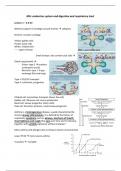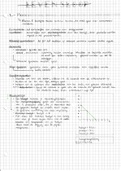MG: endocrine system and digestive and respiratory tract
Lecture 1 – 4-9-23
Without support of cartilage around trachea → collapses
Bronchi: contains cartilage
Yellow: goblet cells
Purple: basal cells
White: ciliated cells
----- upper airways
Small airways: also contain club cells →
Distal lung (alveoli) →
- Green: type 2 → produce
surfactant (round)
- Red cells: type 1 → gas
exchange (flat and long)
Type I: O2/CO2 transport
Type II: surfactant, progenitor
Ciliated cell: mucocilairy transport (clears the cell)
Goblet cell / Mucous cell: mucus production
Basal cell: airway progenitor (stem cells)
Club cell: Secretory proteins, small airway progenitor
Asthma is a heterogeneous disease, usually characterized by
chronic airway inflammation. It is defined by the history of
respiratory symptoms such as wheeze, shortness of breath,
chest tightness and cough that vary over time and in intensity,
together with variable expiratory airflow limitation.”
More asthma and allergies due to living in cleaner environments
Lower PC20 → more severe asthma
Transient → “variable”
,Type I hypersensitivity → allergic asthma (antigens, mast cells, eosinophils)
Type IV hypersensitivity → non-allergic asthma
Inhaled corticosteroid sensitive
- Early-onset allergic eosinophilic airway inflammation
- Extrinsic asthma
- Th2 → GATA3
- Sensitization phase, mast cells, B cells
- Allergens
Inhaled corticosteroid resistant
- Late-onset non-allergic eosinophilic airway inflammation
- Intrinsic asthma
- ILC2 → RORalfa, GATA3
- No sensitization phase, no mast cells
- Pollutants, microbes, glycolipids
Smaller lumen in airway due to increase in muscle size, fibrotic tissue and excess mucus
production
Early airway response
- Bronchoconstriction
- Mast cell-dependent
- IgE-dependent
Late airway response (2nd wave of eosinophils)
- Inflammatory response, oedema, mucus
- T cell-dependent → eosinophil accumulation
- IgE-dependent
Pre-stored histamine in mast cells is released
upon allergen contact
Slide 40.
Often M3 inhibited to decrease airway contraction
Sensory nerves in asthma are generally more activated
- Eosinophils sensitize sensory nerves and produce MBP which blocks M2 receptor →
exaggerated ACh release
Sensory nerves produce neurokinin A which stimulates bronchoconstriction
Neurokinin A → activate NK2 receptors
NK1 receptors on blood vessels and mucus glands (substance P)
,Relaxation pathway – iNANC (inhibitory non-adrenergic non-cholinergic)
- VIP → binds receptor on SMC → relaxation
- NO (produced by nerves and epithelial cells) → guanylyl cyclase → relaxation
VIP, NO and ACh are produced by the same cholinergic nerve → co-transmitters
Dysfunctional NO metabolism in
asthma
Slide 47.
Arginase reduces the bioavailability of L-arginine → less present for NO synthase
MBP blocks the uptake of L-arginine → less NO
production
- This leads to increased responsiveness of
the airways
Slide 48/49 contracting + relaxing pathways
Asthma pharmacotherapy:
- Bronchoprotection (SMC)
- Inhibition of inflammation
Beta-agonists → preferred drug in asthma
Prolonged action due to longer tails in chemical structure
Important slides: 12, 16, 18, 24, 30, 37, 39, 42, 45, 46, 48, 49,
, Lecture 2 – 5-9-23
PDE inhibitors promote SMC relaxation
Theophylline inhibits PDE’s
- PDE3 → bronchodilation
- PDE4 → inflammatory cells decrease
Stimulates CNS and heart → causing
restlessness, insomnia, nausea etc. etc.
Theophylline: narrow therapeutic window
accelerated theophylline metabolism in
women, children and smokers
decreased theophylline metabolism due to old
age, liver failure and heart failure
- Not used outside of ER due to these
fluctuations
Bronchodilators → Anticholinergics block M3
receptors
- Anti-muscarinic drug
Ipratropium: do not penetrate BBB → avoid CNS side effects
- Inhaled → reduce side effects
- Short-acting
Tiotropium: do not penetrate BBB → Avoid CNS side effects
- M3 selective drug is desired
- Kinetic selectivity: same affinity for M1, M2, M3 receptors but way different half-life
from these receptors
- Slow metabolism, due to “sticky” behavior to M3 receptor compared to M2 receptor
Single mediator approach: only reasonable for anticholinergic drugs → (muscarinic receptors
Histamine – induces bronchoconstriction
Cholinergic reflex
Eosinophilic cells → inflammation
Tiotropium inhibits IL-13-induced goblet cell differentiation in vitro






